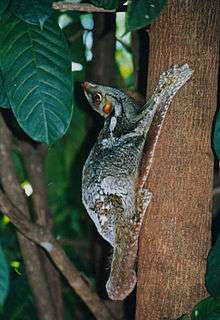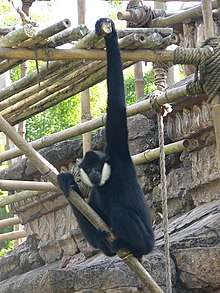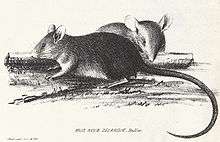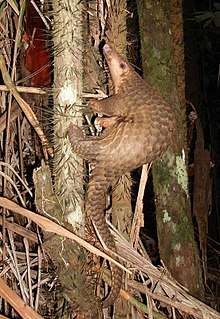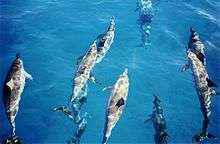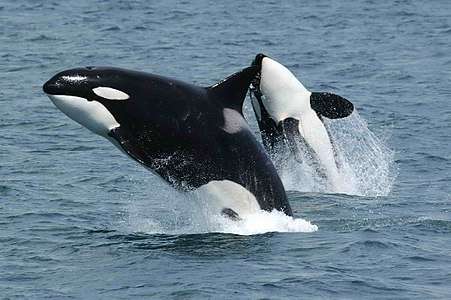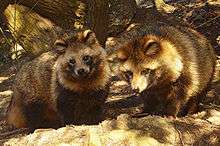List of mammals of Vietnam
This is a list of the mammal species recorded in Vietnam. According to the Checklist of Wild Mammal Species of Vietnam,[1] there are 295 mammal species in Vietnam. On basis of a list derived from the IUCN Red List which lists species of mammals there are 231 mammal species in Vietnam, of which 11 are critically endangered, 11 are endangered, 23 are vulnerable, and 2 are near threatened.[2]
The following tags are used to highlight each species' conservation status as assessed by the International Union for Conservation of Nature:
| EX | Extinct | No reasonable doubt that the last individual has died. |
| EW | Extinct in the wild | Known only to survive in captivity or as a naturalized populations well outside its previous range. |
| CR | Critically endangered | The species is in imminent risk of extinction in the wild. |
| EN | Endangered | The species is facing an extremely high risk of extinction in the wild. |
| VU | Vulnerable | The species is facing a high risk of extinction in the wild. |
| NT | Near threatened | The species does not meet any of the criteria that would categorise it as risking extinction but it is likely to do so in the future. |
| LC | Least concern | There are no current identifiable risks to the species. |
| DD | Data deficient | There is inadequate information to make an assessment of the risks to this species. |
Some species were assessed using an earlier set of criteria. Species assessed using this system have the following instead of near threatened and least concern categories:
| LR/cd | Lower risk/conservation dependent | Species which were the focus of conservation programmes and may have moved into a higher risk category if that programme was discontinued. |
| LR/nt | Lower risk/near threatened | Species which are close to being classified as vulnerable but are not the subject of conservation programmes. |
| LR/lc | Lower risk/least concern | Species for which there are no identifiable risks. |
Subclass: Theria
Infraclass: Eutheria
Order: Proboscidea (elephants)
The elephants comprise three living species and are the largest living land animals.
- Family: Elephantidae (elephants)
- Genus: Elephas
- Asian elephant, Elephas maximus EN
- Indian elephant, Elephas maximus indicus EN
- Asian elephant, Elephas maximus EN
- Genus: Elephas
Order: Sirenia (manatees and dugongs)
Sirenia is an order of fully aquatic, herbivorous mammals that live in rivers and marine wetlands. It includes four extant species, three manatees and the dugong, and the extinct Stellar's sea cow.
- Family: Dugongidae
Order: Scandentia (treeshrews)
The treeshrews are small mammals native to the tropical forests of Southeast Asia. Although called treeshrews, they are not true shrews and are not all arboreal.
- Family: Tupaiidae (tree shrews)
- Genus: Dendrogale
- Northern smooth-tailed treeshrew, Dendrogale murina LR/lc
- Genus: Tupaia
- Northern treeshrew, Tupaia belangeri LR/lc
- Genus: Dendrogale
Order: Dermoptera (colugos)
The two species of colugos make up the order Dermoptera. They are arboreal gliding mammals found in Southeast Asia.
- Family: Cynocephalidae (flying lemurs)
- Genus: Cynocephalus
- Sunda flying lemur, Galeopterus variegatus LR/lc
- Genus: Cynocephalus
Order: Primates
The order Primates contains humans and their closest relatives: lemurs, lorisoids, monkeys, and apes.
- Suborder: Strepsirrhini
- Infraorder: Lemuriformes
- Superfamily: Lorisoidea
- Family: Lorisidae (lorises, bushbabies)
- Genus: Nycticebus
- Bengal slow loris, Nycticebus bengalensis DD
- Pygmy slow loris, Nycticebus pygmaeus VU
- Genus: Nycticebus
- Family: Lorisidae (lorises, bushbabies)
- Superfamily: Lorisoidea
- Infraorder: Lemuriformes
- Suborder: Haplorhini
- Infraorder: Simiiformes
- Parvorder: Catarrhini
- Superfamily: Cercopithecoidea
- Family: Cercopithecidae (Old World monkeys)
- Genus: Macaca
- Stump-tailed macaque, Macaca arctoides VU
- Assam macaque, Macaca assamensis VU
- Crab-eating macaque, Macaca fascicularis LR/nt
- Northern pigtail macaque, Macaca leonina VU
- Rhesus macaque, Macaca mulatta LR/nt
- Genus: Macaca
- Subfamily: Colobinae
- Genus: Trachypithecus
- Delacour's langur, Trachypithecus delacouri CR
- Indochinese black langur, Trachypithecus ebenus
- Francois' langur, Trachypithecus francoisi VU
- Germain's langur, Trachypithecus germaini EN
- Hatinh langur, Trachypithecus hatinhensis EN
- Annamese langur, Trachypithecus margarita
- Phayre's leaf monkey, Trachypithecus phayrei EN
- Indochinese gray langur, Trachypithecus phayrei crepusculus or Trachypithecus crepusculus
- White-headed langur, Trachypithecus poliocephalus CR
- Golden-headed langur or Cat Ba langur Trachypithecus poliocephalus poliocephalus DD
- Genus: Pygathrix
- Gray-shanked douc, Pygathrix cinerea CR
- Red-shanked douc, Pygathrix nemaeus EN
- Black-shanked douc, Pygathrix nigripes EN
- Genus: Rhinopithecus
- Tonkin snub-nosed langur, Rhinopithecus avunculus CR
- Genus: Trachypithecus
- Family: Cercopithecidae (Old World monkeys)
- Superfamily: Hominoidea
- Family: Hylobatidae (gibbons)
- Genus: Nomascus
- Black crested gibbon, Nomascus concolor EN
- Yellow-cheeked crested gibbon, Nomascus gabriellae VU
- White-cheeked crested gibbon, Nomascus leucogenys DD
- Eastern black crested gibbon, Nomascus nasutus CR
- Northern buffed-cheeked gibbon, Nomascus annamensis
- Southern white-cheeked gibbon, Nomascus siki EN
- Genus: Nomascus
- Family: Hylobatidae (gibbons)
- Superfamily: Cercopithecoidea
- Parvorder: Catarrhini
- Infraorder: Simiiformes
Order: Rodentia (rodents)
Rodents make up the largest order of mammals, with over 40% of mammalian species. They have two incisors in the upper and lower jaw which grow continually and must be kept short by gnawing. Most rodents are small though the capybara can weigh up to 45 kg (99 lb).
- Suborder: Hystricognathi
- Family: Hystricidae (Old World porcupines)
- Genus: Atherurus
- Asiatic brush-tailed porcupine, Atherurus macrourus LR/lc
- Genus: Hystrix
- Malayan porcupine, Hystrix brachyura VU
- Genus: Atherurus
- Family: Hystricidae (Old World porcupines)
- Suborder: Sciurognathi
- Family: Sciuridae (squirrels)
- Subfamily: Ratufinae
- Genus: Ratufa
- Black giant squirrel, Ratufa bicolor LR/lc
- Genus: Ratufa
- Subfamily: Sciurinae
- Tribe: Pteromyini
- Genus: Belomys
- Hairy-footed flying squirrel, Belomys pearsonii LR/nt
- Genus: Hylopetes
- Particolored flying squirrel, Hylopetes alboniger EN
- Gray-cheeked flying squirrel, Hylopetes lepidus LR/lc
- Indochinese flying squirrel, Hylopetes phayrei LR/lc
- Red-cheeked flying squirrel, Hylopetes spadiceus LR/lc
- Genus: Petaurista
- Spotted giant flying squirrel, Petaurista elegans LR/lc
- Genus: Belomys
- Tribe: Pteromyini
- Subfamily: Callosciurinae
- Genus: Callosciurus
- Finlayson's squirrel, Callosciurus finlaysonii LR/lc
- Inornate squirrel, Callosciurus inornatus LR/lc
- Black-striped squirrel, Callosciurus nigrovittatus LR/lc
- Genus: Dremomys
- Perny's long-nosed squirrel, Dremomys pernyi LR/lc
- Red-hipped squirrel, Dremomys pyrrhomerus LR/lc
- Asian red-cheeked squirrel, Dremomys rufigenis LR/lc
- Genus: Menetes
- Berdmore's ground squirrel, Menetes berdmorei LR/lc
- Genus: Sundasciurus
- Horse-tailed squirrel, Sundasciurus hippurus LR/lc
- Genus: Tamiops
- Himalayan striped squirrel, Tamiops macclellandi LR/lc
- Maritime striped squirrel, Tamiops maritimus LR/lc
- Cambodian striped squirrel, Tamiops rodolphei LR/lc
- Swinhoe's striped squirrel, Tamiops swinhoei LR/lc
- Genus: Callosciurus
- Subfamily: Ratufinae
- Family: Platacanthomyidae
- Genus: Typhlomys
- Chapa pygmy dormouse, Typhlomys chapensis CR
- Genus: Typhlomys
- Family: Spalacidae
- Subfamily: Rhizomyinae
- Genus: Rhizomys
- Hoary bamboo rat, Rhizomys pruinosus LR/lc
- Chinese bamboo rat, Rhizomys sinensis LR/lc
- Large bamboo rat, Rhizomys sumatrensis LR/lc
- Genus: Rhizomys
- Subfamily: Rhizomyinae
- Family: Muridae (mice, rats, voles, gerbils, hamsters, etc.)
- Subfamily: Murinae
- Genus: Bandicota
- Greater bandicoot rat, Bandicota indica LR/lc
- Savile's bandicoot rat, Bandicota savilei LR/lc
- Genus: Berylmys
- Small white-toothed rat, Berylmys berdmorei LR/lc
- Bower's white-toothed rat, Berylmys bowersi LR/lc
- Kenneth's white-toothed rat, Berylmys mackenziei LR/lc
- Genus: Chiromyscus
- Fea's tree rat, Chiromyscus chiropus LR/lc
- Genus: Chiropodomys
- Pencil-tailed tree mouse, Chiropodomys gliroides LR/lc
- Genus: Hapalomys
- Delacour's marmoset rat, Hapalomys delacouri LR/nt
- Genus: Leopoldamys
- Edwards's long-tailed giant rat, Leopoldamys edwardsi LR/lc
- Long-tailed giant rat, Leopoldamys sabanus LR/lc
- Genus: Maxomys
- Mo's spiny rat, Maxomys moi LR/lc
- Red spiny rat, Maxomys surifer LR/lc
- Genus: Mus
- Ryukyu mouse, Mus caroli LR/lc
- Fawn-colored mouse, Mus cervicolor LR/lc
- Cook's mouse, Mus cookii LR/lc
- Gairdner's shrewmouse, Mus pahari LR/lc
- Shortridge's mouse, Mus shortridgei LR/lc
- Genus: Niviventer
- Chestnut white-bellied rat, Niviventer fulvescens LR/lc
- Lang Bian white-bellied rat, Niviventer langbianis LR/lc
- Tenasserim white-bellied rat, Niviventer tenaster LR/lc
- Genus: Rattus
- Rice-field rat, Rattus argentiventer LR/lc
- Polynesian rat, Rattus exulans LR/lc
- Lesser rice-field rat, Rattus losea LR/lc
- Himalayan field rat, Rattus nitidus LR/lc
- Osgood's rat, Rattus osgoodi LR/lc
- Sikkim rat, Rattus sikkimensis VU
- Tanezumi rat, Rattus tanezumi LR/lc
- Genus: Vandeleuria
- Asiatic long-tailed climbing mouse, Vandeleuria oleracea LR/lc
- Genus: Bandicota
- Subfamily: Murinae
- Family: Sciuridae (squirrels)
Order: Lagomorpha (lagomorphs)
The lagomorphs comprise two families, Leporidae (hares and rabbits), and Ochotonidae (pikas). Though they can resemble rodents, and were classified as a superfamily in that order until the early 20th century, they have since been considered a separate order. They differ from rodents in a number of physical characteristics, such as having four incisors in the upper jaw rather than two.
- Family: Leporidae (rabbits, hares)
- Genus: Nesolagus
- Annamite striped rabbit, Nesolagus timminsi DD
- Genus: Lepus
- Burmese hare, Lepus peguensis LR/lc
- Chinese hare, Lepus sinensis LR/lc
- Genus: Nesolagus
Order: Eulipotyphla (shrews, hedgehogs, gymnures, moles and solenodons)
Eulipotyphlans are insectivorous mammals. Shrews and solenodons resemble mice, hedgehogs carry spines, gymnures look more like large rats, while moles are stout-bodied burrowers.
- Family: Erinaceidae (hedgehogs and gymnures)
- Subfamily: Galericinae
- Genus: Hylomys
- Shrew gymnure, Hylomys sinensis LR/nt
- Short-tailed gymnure, Hylomys suillus LR/lc
- Genus: Hylomys
- Subfamily: Galericinae
- Family: Soricidae (shrews)
- Subfamily: Crocidurinae
- Genus: Crocidura
- Crocidura annamitensis
- Grey shrew, Crocidura attenuata LR/lc
- Southeast Asian shrew, Crocidura fuliginosa LR/lc
- Crocidura guy
- Crocidura indochinensis
- Crocidura kegoensis
- Crocidura phanluongi
- Crocidura phuquocensis
- Crocidura sokolovi
- Crocidura wuchihensis
- Crocidura zaitsevi
- Genus: Suncus
- Asian house shrew, Suncus murinus LR/lc
- Genus: Crocidura
- Subfamily: Soricinae
- Tribe: Anourosoricini
- Genus: Anourosorex
- Chinese mole shrew, Anourosorex squamipes LR/lc
- Genus: Anourosorex
- Tribe: Blarinellini
- Genus: Blarinella
- Blarinella griselda
- Genus: Blarinella
- Tribe: Nectogalini
- Genus: Chimarrogale
- Himalayan water shrew, Chimarrogale himalayica LR/lc
- Genus: Soriculus
- Long-tailed brown-toothed shrew, Soriculus leucops LR/lc
- Long-tailed mountain shrew, Soriculus macrurus LR/lc
- Lowe's shrew, Soriculus parca LR/lc
- Genus: Chimarrogale
- Tribe: Anourosoricini
- Subfamily: Crocidurinae
- Family: Talpidae (moles)
- Subfamily: Talpinae
- Tribe: Talpini
- Genus: Euroscaptor
- Greater Chinese mole, Euroscaptor grandis LR/lc
- Himalayan mole, Euroscaptor micrura LR/lc
- Small-toothed mole, Euroscaptor parvidens CR
- Genus: Euroscaptor
- Tribe: Talpini
- Subfamily: Talpinae
Order: Chiroptera (bats)
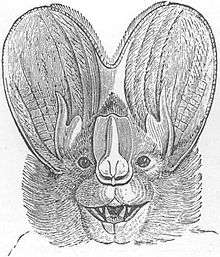
The bats' most distinguishing feature is that their forelimbs are developed as wings, making them the only mammals capable of flight. Bat species account for about 20% of all mammals.
- Family: Pteropodidae (flying foxes, Old World fruit bats)
- Subfamily: Pteropodinae
- Genus: Cynopterus
- Cynopterus, Cynopterus brachyotis LR/lc
- Greater short-nosed fruit bat, Cynopterus sphinx LR/lc
- Genus: Megaerops
- Megaerops ecaudatus LR/lc
- Ratanaworabhan's fruit bat, Megaerops niphanae LR/lc
- Genus: Pteropus
- Small flying-fox, Pteropus hypomelanus LR/lc
- Lyle's flying fox, Pteropus lylei LR/lc
- Genus: Rousettus
- Geoffroy's rousette, Rousettus amplexicaudatus LR/lc
- Leschenault's rousette, Rousettus leschenaulti LR/lc
- Genus: Cynopterus
- Subfamily: Macroglossinae
- Genus: Macroglossus
- Long-tongued nectar bat, Macroglossus minimus LR/lc
- Long-tongued fruit bat, Macroglossus sobrinus LR/lc
- Genus: Macroglossus
- Subfamily: Pteropodinae
- Family: Vespertilionidae
- Subfamily: Kerivoulinae
- Genus: Kerivoula
- Papillose woolly bat, Kerivoula papillosa LR/lc
- Painted bat, Kerivoula picta LR/lc
- Genus: Kerivoula
- Subfamily: Myotinae
- Genus: Myotis
- Large-footed bat, Myotis adversus LR/lc
- Large myotis, Myotis chinensis LR/lc
- Lesser large-footed bat, Myotis hasseltii LR/lc
- Horsfield's bat, Myotis horsfieldii LR/lc
- Kashmir cave bat, Myotis longipes VU
- Whiskered myotis, Myotis muricola LR/lc
- Himalayan whiskered bat, Myotis siligorensis LR/lc
- Annamit myotis, Myotis annamiticus
- Genus: Myotis
- Subfamily: Vespertilioninae
- Genus: Hypsugo
- Cadorna's pipistrelle, Hypsugo cadornae LR/nt
- Chinese pipistrelle, Hypsugo pulveratus LR/nt
- Genus: Ia
- Great evening bat, Ia io LR/nt
- Genus: Nyctalus
- Common noctule, Nyctalus noctula LR/lc
- Genus: Pipistrellus
- Kelaart's pipistrelle, Pipistrellus ceylonicus LR/lc
- Java pipistrelle, Pipistrellus javanicus LR/lc
- Mount Popa pipistrelle, Pipistrellus paterculus LR/nt
- Least pipistrelle, Pipistrellus tenuis LR/lc
- Genus: Scotomanes
- Harlequin bat, Scotomanes ornatus LR/nt
- Genus: Scotophilus
- Greater Asiatic yellow bat, Scotophilus heathi LR/lc
- Genus: Hypsugo
- Subfamily: Murininae
- Genus: Murina
- Round-eared tube-nosed bat, Murina cyclotis LR/lc
- Hutton's tube-nosed bat, Murina huttoni LR/nt
- Scully's tube-nosed bat, Murina tubinaris LR/lc
- Genus: Murina
- Subfamily: Miniopterinae
- Genus: Miniopterus
- Western bent-winged bat, Miniopterus magnater LR/lc
- Small bent-winged bat, Miniopterus pusillus LR/lc
- Schreibers' long-fingered bat, Miniopterus schreibersii LC
- Genus: Miniopterus
- Subfamily: Kerivoulinae
- Family: Molossidae
- Genus: Chaerephon
- Wrinkle-lipped free-tailed bat, Chaerephon plicata LR/lc
- Genus: Chaerephon
- Family: Emballonuridae
- Genus: Taphozous
- Black-bearded tomb bat, Taphozous melanopogon LR/lc
- Theobald's tomb bat, Taphozous theobaldi LR/lc
- Genus: Taphozous
- Family: Megadermatidae
- Genus: Megaderma
- Greater false vampire bat, Megaderma lyra LR/lc
- Lesser false vampire bat, Megaderma spasma LR/lc
- Genus: Megaderma
- Family: Rhinolophidae
- Subfamily: Rhinolophinae
- Genus: Rhinolophus
- Intermediate horseshoe bat, Rhinolophus affinis LR/lc
- Bornean horseshoe bat, Rhinolophus borneensis LR/lc
- Woolly horseshoe bat, Rhinolophus luctus LR/lc
- Big-eared horseshoe bat, Rhinolophus macrotis LR/lc
- Malayan horseshoe bat, Rhinolophus malayanus LR/lc
- Marshall's horseshoe bat, Rhinolophus marshalli LR/nt
- Bourret's horseshoe bat, Rhinolophus paradoxolophus VU
- Pearson's horseshoe bat, Rhinolophus pearsoni LR/lc
- Rufous horseshoe bat, Rhinolophus rouxi LR/lc
- Chinese rufous horseshoe bat, Rhinolophus sinicus LR/lc
- Lesser brown horseshoe bat, Rhinolophus stheno LR/lc
- Little Nepalese horseshoe bat, Rhinolophus subbadius DD
- Thomas's horseshoe bat, Rhinolophus thomasi LR/nt
- Genus: Rhinolophus
- Subfamily: Hipposiderinae
- Genus: Aselliscus
- Stoliczka's trident bat, Aselliscus stoliczkanus LR/lc
- Genus: Coelops
- Tail-less leaf-nosed bat, Coelops frithii LR/lc
- Genus: Hipposideros
- Great roundleaf bat, Hipposideros armiger LR/lc
- Dusky roundleaf bat, Hipposideros ater LR/lc
- Ashy roundleaf bat, Hipposideros cineraceus LR/lc
- Diadem roundleaf bat, Hipposideros diadema LR/lc
- Fulvus roundleaf bat, Hipposideros fulvus LR/lc
- Intermediate roundleaf bat, Hipposideros larvatus LR/lc
- Pratt's roundleaf bat, Hipposideros pratti LR/nt
- Lesser great leaf-nosed bat, Hipposideros turpis EN
- Genus: Aselliscus
- Subfamily: Rhinolophinae
Order: Pholidota (pangolins)
The order Pholidota comprises the eight species of pangolin. Pangolins are anteaters and have the powerful claws, elongated snout and long tongue seen in the other unrelated anteater species.
- Family: Manidae
- Genus: Manis
- Sunda pangolin, Manis javanica LR/nt
- Chinese pangolin, Manis pentadactyla LR/nt
- Genus: Manis
Order: Cetacea (whales)
The order Cetacea includes whales, dolphins and porpoises. They are the mammals most fully adapted to aquatic life with a spindle-shaped nearly hairless body, protected by a thick layer of blubber, and forelimbs and tail modified to provide propulsion underwater.
- Suborder: Mysticeti (baleen whales)
- Family: Eschrichtiidae
- Genus: Eschrichtius
- Western gray whale, Eschrichtius robustus CR[3]
- Genus: Eschrichtius
- Family: Eschrichtiidae
- Family: Balaenopteridae (rorquals)
- Subfamily: Megapterinae
- Genus: Megaptera
- Humpback whale, Megaptera novaeangliae LC[4]
- Subfamily: Balaenopterinae
- Genus: Balaenoptera
- Common minke whale, Balaenoptera acutorostrata (Sea of Japan and Yellow/Bohai Seas) EN
- Omura's whale, Balaenoptera omurai DD
- Eden's whale, Balaenoptera edeni DD
- Northern blue whale, Balaenoptera musculus CR[4]
- Genus: Balaenoptera
- Genus: Megaptera
- Subfamily: Megapterinae
- Suborder: Odontoceti (toothed whales)
- Superfamily: Platanistoidea
- Family: Phocoenidae
- Genus: Neophocaena
- Finless porpoise, Neophocaena phocaenoides DD
- Genus: Neophocaena
- Family: Kogiidae
- Genus: Kogia
- Dwarf sperm whale, Kogia sima LR/lc
- Genus: Kogia
- Family: Ziphidae
- Subfamily: Hyperoodontinae
- Genus: Mesoplodon
- Blainville's beaked whale, Mesoplodon densirostris DD
- Genus: Mesoplodon
- Subfamily: Hyperoodontinae
- Family: Delphinidae (marine dolphins)
- Genus: Sousa
- Sousa chinensis DD
- Genus: Tursiops
- Bottlenose dolphin, Tursiops aduncus DD
- Genus: Stenella
- Spinner dolphin, Stenella longirostris LR/cd
- Genus: Delphinus
- Common dolphin, Delphinus capensis LR/lc
- Genus: Lagenodelphis
- Fraser's dolphin, Lagenodelphis hosei DD
- Genus: Grampus
- Risso's dolphin, Grampus griseus DD
- Genus: Peponocephala
- Melon-headed whale, Peponocephala electra LR/lc
- Genus: Feresa
- Pygmy killer whale, Feresa attenuata DD
- Genus: Orcinus
- Orca, Orcinus orca LR/cd
- Genus: Orcaella
- Irrawaddy dolphin, Orcaella brevirostris DD
- Genus: Sousa
- Family: Phocoenidae
- Superfamily: Platanistoidea
Order: Carnivora (carnivorans)

There are over 260 species of carnivorans, the majority of which feed primarily on meat. They have a characteristic skull shape and dentition.
- Suborder: Feliformia
- Family: Felidae (cats)
- Subfamily: Felinae
- Genus: Catopuma
- Asian golden cat, Catopuma temminckii VU
- Genus: Felis
- Jungle cat, Felis chaus LC
- Genus: Pardofelis
- Marbled cat, Pardofelis marmorata VU
- Genus: Prionailurus
- Leopard cat, Prionailurus bengalensis LC
- Fishing cat, Prionailurus viverrinus VU
- Genus: Catopuma
- Subfamily: Pantherinae
- Genus: Neofelis
- Clouded leopard, Neofelis nebulosa VU
- Genus: Panthera
- Indochinese leopard, Panthera pardus delacouri NT
- Indochinese tiger, Panthera tigris corbetti EN
- Genus: Neofelis
- Subfamily: Felinae
- Family: Viverridae (civets, mongooses, etc.)
- Subfamily: Paradoxurinae
- Genus: Arctictis
- Binturong, Arctictis binturong LR/lc
- Genus: Arctogalidia
- Small-toothed palm civet, Arctogalidia trivirgata LR/lc
- Genus: Paguma
- Masked palm civet, Paguma larvata LR/lc
- Genus: Paradoxurus
- Asian palm civet, Paradoxurus hermaphroditus LR/lc
- Genus: Arctictis
- Subfamily: Hemigalinae
- Genus: Chrotogale
- Owston's palm civet, Chrotogale owstoni VU
- Genus: Cynogale
- Otter civet, Cynogale bennettii EN
- Genus: Chrotogale
- Subfamily: Prionodontinae
- Genus: Prionodon
- Spotted linsang, Prionodon pardicolor LR/lc
- Genus: Prionodon
- Subfamily: Viverrinae
- Genus: Viverra
- Large-spotted civet, Viverra megaspila LR/lc
- Large Indian civet, Viverra zibetha LR/lc
- Genus: Viverricula
- Small Indian civet, Viverricula indica LR/lc
- Genus: Viverra
- Subfamily: Paradoxurinae
- Family: Herpestidae (mongooses)
- Genus: Herpestes
- Short-tailed mongoose, Herpestes brachyurus LR/lc
- Small Asian mongoose, Herpestes javanicus LR/lc
- Crab-eating mongoose, Herpestes urva LR/lc
- Genus: Herpestes
- Family: Felidae (cats)
- Suborder: Caniformia
- Family: Canidae (dogs, foxes)
- Genus: Vulpes
- Red fox, Vulpes vulpes LC
- Genus: Nyctereutes
- Raccoon dog, Nyctereutes procyonoides LC
- Genus: Canis
- Siamese jackal, Canis aureus cruesemanni LC
- Genus: Cuon
- Ussuri dhole, Cuon alpinus alpinus EN
- Genus: Vulpes
- Family: Ursidae (bears)
- Genus: Ursus
- Asiatic black bear, Ursus thibetanus VU
- Genus: Helarctos
- Sun bear, Helarctos malayanus DD
- Genus: Ailuropoda
- Giant panda Ailuropoda melanoleuca EX
- Genus: Ursus
- Family: Mustelidae (mustelids)
- Genus: Mustela
- Yellow-bellied weasel, Mustela kathiah LR/lc
- Siberian weasel, Mustela sibirica LR/lc
- Back-striped weasel, Mustela strigidorsa VU
- Genus: Martes
- Martes flavigula LR/lc
- Genus: Arctonyx
- Hog badger, Arctonyx collaris LR/lc
- Genus: Melogale
- Chinese ferret badger, Melogale moschata LR/lc
- Burmese ferret-badger, Melogale personata LR/lc
- Genus: Lutra
- European otter, Lutra lutra NT
- Hairy-nosed otter, Lutra sumatrana DD
- Genus: Lutrogale
- Smooth-coated otter, Lutrogale perspicillata VU
- Genus: Aonyx
- Oriental small-clawed otter, Aonyx cinereus NT
- Genus: Mustela
- Family: Canidae (dogs, foxes)
Order: Perissodactyla (odd-toed ungulates)
The odd-toed ungulates are browsing and grazing mammals. They are usually large to very large, and have relatively simple stomachs and a large middle toe.
- Family: Tapiridae (tapirs)
- Genus: Tapirus
- Malayan tapir, Tapirus indicus VU
- Genus: Tapirus
- Family: Rhinocerotidae
- Genus: Rhinoceros
- Vietnamese Sunda rhinoceros, Rhinoceros sondaicus annamiticus EX (extirpated 2010)
- Genus: Dicerorhinus
- Northern Sumatran rhinoceros, Dicerorhinus sumatrensis lasiotis EX
- Genus: Epiaceratherium
- Genus: Rhinoceros
Order: Artiodactyla (even-toed ungulates)
The even-toed ungulates are ungulates whose weight is borne about equally by the third and fourth toes, rather than mostly or entirely by the third as in perissodactyls. There are about 220 artiodactyl species, including many that are of great economic importance to humans.
- Family: Suidae (pigs)
- Family: Tragulidae
- Genus: Tragulus
- Tragulus kanchil
- Vietnam mouse-deer, Tragulus versicolor
- Genus: Tragulus
- Family: Moschidae
- Genus: Moschus
- Dwarf musk deer, Moschus berezovskii LR/nt
- Genus: Moschus
- Family: Cervidae (deer)
- Subfamily: Cervinae
- Genus: Cervus
- Eld's deer, Cervus eldii VU
- Sika deer, Cervus nippon LR/lc
- Subspecies Vietnamese sika deer, Cervus nippon pseudaxis
- Sambar deer, Cervus unicolor LR/lc
- Genus: Cervus
- Subfamily: Muntiacinae
- Genus: Muntiacus
- Fea's muntjac, Muntiacus feae DD
- Indian muntjac, Muntiacus muntjak LR/lc
- Truong Son muntjac, Muntiacus truongsonensis DD
- Giant muntjac, Muntiacus vuquangensis DD
- Pu Hoat muntjac, Muntiacus puhoatensis
- Genus: Muntiacus
- Subfamily: Cervinae
- Family: Bovidae (cattle, antelope, sheep, goats)
- Subfamily: Bovinae
- Genus: Bos
- Genus: Pseudonovibos
- Kting voar, Pseudonovibos spiralis EN
- Genus: Pseudoryx
- Saola, Pseudoryx nghetinhensis CR
- Subfamily: Caprinae
- Genus: Capricornis
- Species: Capricornis milneedwardsii
- Indochinese serow, Capricornis milneedwardsii maritimus
- Species: Capricornis milneedwardsii
- Genus: Capricornis
- Subfamily: Bovinae
See also
Notes
- Published jointly by Primate Research Institute (Kyoto University, Inuyama, Japan) and Department of Vertebrate Zoology (Institute of Ecology and Biological Resources, Hanoi, Vietnam), 2008
- This list is derived from the IUCN Red List which lists species of mammals and includes those mammals that have recently been classified as extinct (since 1500 AD). The taxonomy and naming of the individual species is based on those used in existing Wikipedia articles as of 21 May 2007 and supplemented by the common names and taxonomy from the IUCN, Smithsonian Institution, or University of Michigan where no Wikipedia article was available.
- 2014. Chuẩn hóa lại tên cá voi xám trong bộ sưu tập mẫu vật của bảo tàng lịch sử tỉnh Quảng Ninh Archived 2017-03-12 at the Wayback Machine. Retrieved on March 09, 2017
- Conservation Status of Marine Mammals in Cambodian Waters, Including Seven New Cetacean Records of Occurrence
References
- "Mammal Species of the World". Smithsonian National Museum of Natural History. 2005. Archived from the original on 27 April 2007. Retrieved 22 May 2007.
- "Animal Diversity Web". University of Michigan Museum of Zoology. 1995–2006. Retrieved 22 May 2007.
External links
| Wikimedia Commons has media related to Mammals of Vietnam. |

